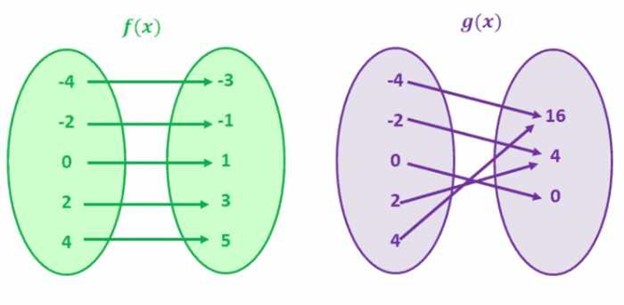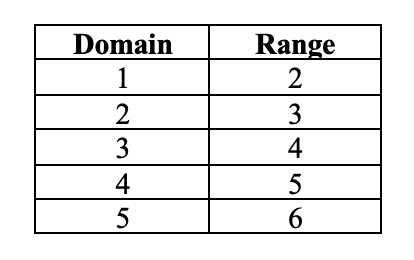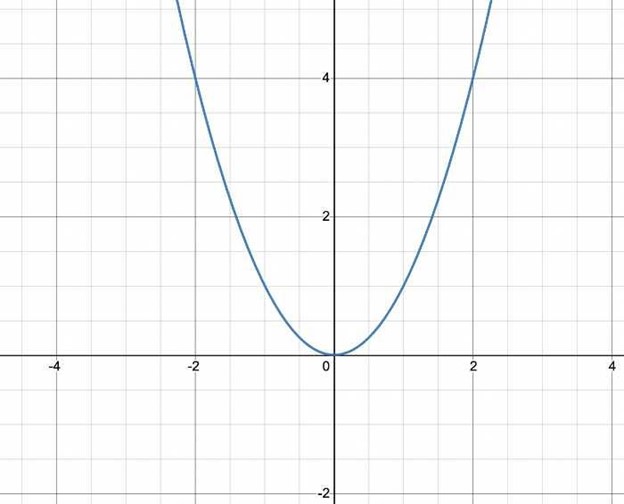One to One Functions - Graph, Examples | Horizontal Line Test
What is a One to One Function?
A one-to-one function is a mathematical function in which each input corresponds to a single output. In other words, for each x, there is only one y and vice versa. This implies that the graph of a one-to-one function will never intersect.
The input value in a one-to-one function is noted as the domain of the function, and the output value is known as the range of the function.
Let's study the images below:

For f(x), every value in the left circle correlates to a unique value in the right circle. Similarly, each value on the right side correlates to a unique value in the left circle. In mathematical terms, this implies every domain owns a unique range, and every range owns a unique domain. Therefore, this is an example of a one-to-one function.
Here are some other representations of one-to-one functions:
-
f(x) = x + 1
-
f(x) = 2x
Now let's study the second image, which shows the values for g(x).
Be aware of the fact that the inputs in the left circle (domain) do not hold unique outputs in the right circle (range). For example, the inputs -2 and 2 have equal output, i.e., 4. In conjunction, the inputs -4 and 4 have the same output, i.e., 16. We can comprehend that there are identical Y values for multiple X values. Therefore, this is not a one-to-one function.
Here are some other examples of non one-to-one functions:
-
f(x) = x^2
-
f(x)=(x+2)^2
What are the properties of One to One Functions?
One-to-one functions have the following properties:
-
The function has an inverse.
-
The graph of the function is a line that does not intersect itself.
-
They pass the horizontal line test.
-
The graph of a function and its inverse are equivalent with respect to the line y = x.
How to Graph a One to One Function
In order to graph a one-to-one function, you will need to determine the domain and range for the function. Let's examine an easy representation of a function f(x) = x + 1.

Immediately after you have the domain and the range for the function, you ought to chart the domain values on the X-axis and range values on the Y-axis.
How can you tell whether a Function is One to One?
To indicate if a function is one-to-one, we can leverage the horizontal line test. Once you graph the graph of a function, trace horizontal lines over the graph. If a horizontal line passes through the graph of the function at more than one spot, then the function is not one-to-one.
Since the graph of every linear function is a straight line, and a horizontal line doesn’t intersect the graph at more than one point, we can also deduct all linear functions are one-to-one functions. Remember that we do not leverage the vertical line test for one-to-one functions.
Let's examine the graph for f(x) = x + 1. Immediately after you plot the values of x-coordinates and y-coordinates, you need to consider whether a horizontal line intersects the graph at more than one spot. In this instance, the graph does not intersect any horizontal line more than once. This signifies that the function is a one-to-one function.

On the other hand, if the function is not a one-to-one function, it will intersect the same horizontal line more than one time. Let's look at the figure for the f(y) = y^2. Here are the domain and the range values for the function:

Here is the graph for the function:

In this example, the graph meets various horizontal lines. For example, for either domains -1 and 1, the range is 1. In the same manner, for each -2 and 2, the range is 4. This means that f(x) = x^2 is not a one-to-one function.
What is the opposite of a One-to-One Function?
Since a one-to-one function has just one input value for each output value, the inverse of a one-to-one function also happens to be a one-to-one function. The inverse of the function basically undoes the function.
For example, in the event of f(x) = x + 1, we add 1 to each value of x as a means of getting the output, in other words, y. The opposite of this function will subtract 1 from each value of y.
The inverse of the function is denoted as f−1.
What are the properties of the inverse of a One to One Function?
The properties of an inverse one-to-one function are the same as every other one-to-one functions. This means that the inverse of a one-to-one function will hold one domain for each range and pass the horizontal line test.
How do you figure out the inverse of a One-to-One Function?
Figuring out the inverse of a function is very easy. You just have to switch the x and y values. For example, the inverse of the function f(x) = x + 5 is f-1(x) = x - 5.

Considering what we learned previously, the inverse of a one-to-one function undoes the function. Considering the original output value required us to add 5 to each input value, the new output value will require us to deduct 5 from each input value.
One to One Function Practice Questions
Consider the following functions:
-
f(x) = x + 1
-
f(x) = 2x
-
f(x) = x2
-
f(x) = 3x - 2
-
f(x) = |x|
-
g(x) = 2x + 1
-
h(x) = x/2 - 1
-
j(x) = √x
-
k(x) = (x + 2)/(x - 2)
-
l(x) = 3√x
-
m(x) = 5 - x
For every function:
1. Figure out if the function is one-to-one.
2. Draw the function and its inverse.
3. Find the inverse of the function numerically.
4. State the domain and range of each function and its inverse.
5. Employ the inverse to determine the value for x in each formula.
Grade Potential Can Help You Learn You Functions
If you are having problems trying to understand one-to-one functions or similar topics, Grade Potential can connect you with a 1:1 instructor who can help. Our Irvine math tutors are experienced professionals who support students just like you improve their skills of these concepts.
With Grade Potential, you can learn at your own pace from the comfort of your own home. Schedule a call with Grade Potential today by calling (949) 373-3437 to learn more about our teaching services. One of our consultants will call you to better determine your needs to find the best instructor for you!




